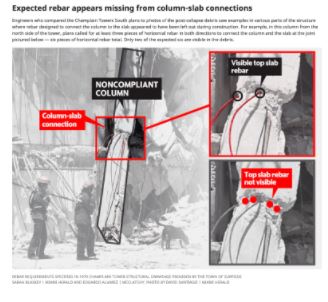
IN TODAY’S MIAMI HERALD: Our reimagined newspaper features part one of a rolling series Anatomy of Collapse, an in-depth analysis of Champlain Towers South’s structural drawings, building codes and debris photos done in consultation with engineers and construction experts. 🧵 

The analysis revealed a poorly designed building –– even for the 1970s when the plans were originally drawn and codes were less rigorous –– where most of the column designs were too narrow and plans for the pool deck area show potential weaknesses. miamiherald.com/news/local/com…
“The design was faulty,” said Eugenio Santiago, a licensed structural engineer and retired chief building official for Key Biscayne. Overcrowded columns were “cracking from day one,” he said. 

The weakest part of the column design was where the column and slab connected, according to engineers consulted by the Herald.
Without a change in the plans, the contractor would have to choose between overcrowding the column or under-reinforcing the connection.
Without a change in the plans, the contractor would have to choose between overcrowding the column or under-reinforcing the connection.
Engineers who looked at photos of the debris said it looked like the contractor left rebar out of the otherwise overcrowded connections, an observation first reported by the New York Times. 

“All of these factors, not having many of these things to code, banded together and I believe contributed to the collapse,” said Abieyuwa Aghayere, professor of structural engineering at Drexel University who reviewed the building plans and performed calculations for the Herald.
While design flaws alone were unlikely to have initiated the collapse that happened 40 years after construction, the engineers said the deficiencies could have been the difference between a single floor caving in and the kind of progressive collapse that killed 98 people June 24. 

Although the trigger is still unknown, there is a growing consensus that the Champlain Towers collapse began when the first floor slab failed.
The spindly columns supporting it began to poke through the slab –– a failure called “punching shear.”
The spindly columns supporting it began to poke through the slab –– a failure called “punching shear.”
Punching shear is the most common failure mechanism for flat slab construction featured at Champlain Towers and should have been anticipated by engineers at the time of construction, the engineers said. Again, the design was weak, even for the time, engineers said. 

Despite the dramatic cave-in of the pool deck, if the building had been built to code, the collapse likely would have ended there, engineers consulted by the Herald agreed.
Ultimately, it was the job of the lead engineer, Sergio Breiterman, to verify the designs met the code and perform any necessary calculations.
In 1980, he wrote a letter to the town certifying that Champlain Towers’ design and construction met all of the requirements of the building code at the time.
“We have evidence that clearly it doesn’t [meet code requirements],” said Dawn Lehman, professor of structural engineering at the University of Washington and consultant to the Miami Herald. “That is really problematic.” 

Visit our website or sign up for the E-edition to read the full story, see more explanatory graphics and learn more about how we performed this analysis.
You can look at all of our coverage here: miamiherald.com/e-edition/today
You can look at all of our coverage here: miamiherald.com/e-edition/today
We invite you to take a look at the reimagined Miami Herald, and consider supporting local journalists with a subscription: miamiherald.com/site-services/…
• • •
Missing some Tweet in this thread? You can try to
force a refresh







